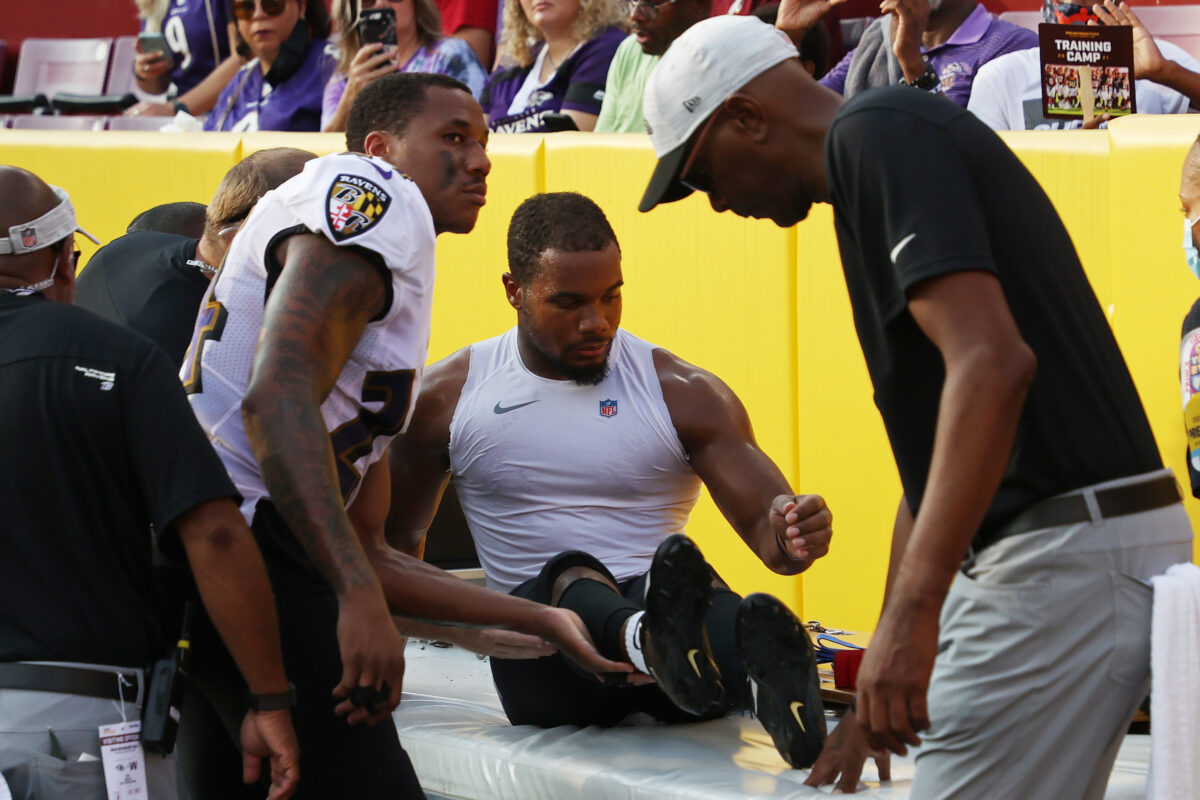In a span of less than three weeks last preseason, the Baltimore Ravens lost running backs J.K. Dobbins, Justice Hill, and Gus Edwards to leg injuries — Dobbins and Edwards suffered torn ACLs, whereas Hill ruptured his Achilles.
With their depth chart in shambles, the team wound up with veterans Devonta Freeman and Latavius Murray as the top options. Neither player is set to return in 2022, however, leaving the Ravens without a single back who carried the ball for the team last season. With that in mind, it’s a good time to preview what Baltimore’s backfield will look like this year.
J.K. Dobbins
Prior to his injury, Dobbins was a popular breakout candidate after he averaged a whopping 6.0 yards per carry as a rookie to go along with nine TDs on just 134 carries. He’s a compact, powerful runner who can break tackles while still possessing elusiveness in the open field. Dobbins is easily the most talented of Baltimore’s options and should fill the primary role.
There’s a caveat within that designation, though, as the Ravens have long been a proponent of the committee approach. In fact, over the past nine seasons there have been only two Baltimore backs to top 1,000 yards in a season: Mark Ingram (1,018 in 2019) and Justin Forsett (1,266 in 2014). Couple that with Dobbins’ perceived limitations as a pass catcher, and it’d be smart to temper any expectations of the Ohio State alum posting RB1 numbers.
Gus Edwards
Steady as she goes has been the mantra for Edwards, who has gained between 710 and 725 yards rushing in each of his three NFL seasons while averaging at least 5.0 yards per carry. Checking in at 6-foot-1, 238 pounds, Edwards is a big back, but with only 10 career touchdowns in 414 carries. He has never shown a penchant for goal-line work; that could certainly be a byproduct of his height making him too large of a target for consistent short-area usage.
Tired of losing your league every season? Be sure to sign up for The Huddle today to gain an award-winning edge on the competition! We have 26 years of experience online building fantasy football champions.
Edwards has yet to show anything as a receiver, either, managing just 18 career receptions. Take that with the lack of scores, and suddenly the fifth-year pro profiles as a middle-of-the-field, early-down back, which limits his upside. Assuming health, Edwards can safely be penciled in as the complementary option to Dobbins.
Mike Davis
Signed in May, Davis is a true journeyman, having played for five NFL clubs in his seven seasons. While he offers little in the way of explosiveness — something his career average of 3.7 YPC can attest to — the veteran is a capable receiver and typically reliable ball carrier with six career fumbles over his 719 total touches, though four of them came in 2021. He’s cut from the same well-worn cloth as Freeman and Murray from last season.
Justice Hill/Tyler Badie
A fourth-round pick in 2019, Hill saw limited opportunities in his first two seasons and then watched his chance for extended work dashed last year by the Achilles injury. He’s more reliable than explosive, and entering the final year of his rookie deal he’ll need to fend off Tyler Badie, who the Ravens snagged in the sixth round of this year’s draft. Badie runs hard and is a capable receiving threat, which might give him a leg up in the battle for a roster spot.
Fantasy football takeaway
If everyone can stay healthy, Dobbins and Edwards should carry the load. Their lone season together in 2020 saw Edwards (144) get more carries than the then-rookie Dobbins (134) while Ingram (72) was also involved.
This season look for the latter’s touches to be redistributed among the top two backs with whoever emerges among Davis, Hill and Badie getting spot duty. Dobbins has borderline top-20 appeal, and Edwards is a solid RB5 depth type. The rest can be bypassed entirely.
